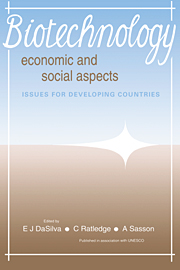Book contents
- Frontmatter
- Contents
- List of contributors
- Preface
- 1 Biotechnology: the socio-economic revolution? A synoptic view of the world status of biotechnology
- 2 Bioethanol production: economic and social considerations in failures and successes
- 3 Biofertilizers: agronomic and environmental impacts and economics
- 4 Microalgal biotechnology: is it an economic success?
- 5 Production of useful biochemicals by higher-plant cell cultures: biotechnological and economic aspects
- 6 Mushroom production – an economic measure in maintenance of food security
- 7 The economic viability of Single Cell Protein (SCP) production in the twenty-first century
- 8 The impact of biotechnology on international commodity trade
- 9 Biotechnology: socio-economic considerations, intercultural perspectives and international viewpoints
- 10 Joint microbial biotechnological ventures in developing countries: social promises and economic considerations
- 11 The economic and social implications of gene technology to developing countries
- 12 Making biotechnology appropriate – and environmentally sound
- 13 Information support for research and development in biotechnological applications
- 14 The effects of emerging biotechnologies on plant and animal agriculture – a viewpoint
- Index
5 - Production of useful biochemicals by higher-plant cell cultures: biotechnological and economic aspects
Published online by Cambridge University Press: 04 August 2010
- Frontmatter
- Contents
- List of contributors
- Preface
- 1 Biotechnology: the socio-economic revolution? A synoptic view of the world status of biotechnology
- 2 Bioethanol production: economic and social considerations in failures and successes
- 3 Biofertilizers: agronomic and environmental impacts and economics
- 4 Microalgal biotechnology: is it an economic success?
- 5 Production of useful biochemicals by higher-plant cell cultures: biotechnological and economic aspects
- 6 Mushroom production – an economic measure in maintenance of food security
- 7 The economic viability of Single Cell Protein (SCP) production in the twenty-first century
- 8 The impact of biotechnology on international commodity trade
- 9 Biotechnology: socio-economic considerations, intercultural perspectives and international viewpoints
- 10 Joint microbial biotechnological ventures in developing countries: social promises and economic considerations
- 11 The economic and social implications of gene technology to developing countries
- 12 Making biotechnology appropriate – and environmentally sound
- 13 Information support for research and development in biotechnological applications
- 14 The effects of emerging biotechnologies on plant and animal agriculture – a viewpoint
- Index
Summary
Plant secondary metabolites
The distribution of secondary metabolites in plants is far more restricted than that of primary metabolites; a compound is often only found in a few species, or even within a few varieties within a species. Though their function in plant metabolism is unclear, nevertheless they may have an ecological role, e.g. as sexual attractants for pollinating insects or in defence mechanisms against predators (Grisebach, 1988). Secondary metabolites often accumulate in the plant in small quantities sometimes in specialized cells. Hence their extraction is often difficult. Among them are many compounds which are commercially important as medicinal substances, fragrances, food additives (pigments, flavouring and aromatic compounds) and pesticides (Heble & Chadha, 19856; Kurz, 1989).
In spite of the progress made in organic synthesis or semi-synthesis of a wide range of compounds similar to those produced by the plants, extraction of secondary metabolites from plants is still of considerable commercial importance. A large number of these metabolites are difficult or virtually impossible to synthesize at economic values. In several cases, the natural product is more easily accepted by consumers than an artificially produced one. The term ‘secondary metabolite’ still applies to a large number of aromas or fragrances which are mixtures of hundreds of different compounds. This is the case with many essential oils, flavours and fragrances. Many of the components, moreover, have complex molecular structures (e.g. some alkaloids and glycosides).
There is great interest in developing alternatives to the intact plant for the production of plant secondary metabolites.
- Type
- Chapter
- Information
- Biotechnology: Economic and Social AspectsIssues for Developing Countries, pp. 81 - 109Publisher: Cambridge University PressPrint publication year: 1992
- 5
- Cited by

